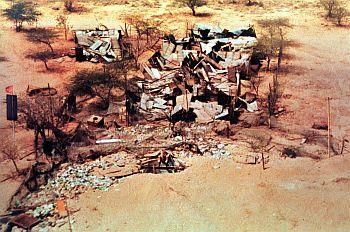 "This is the picture of ground zero where the thermo-nuclear device was detonated in May 1998 in Pokharan. No crater was found at all! This picture tells the story that we have to do more homework. Indeed, we have to do more honest homework." said K Santhanam, former Defence Research and Development Organisation scientist dramatically holding the picture in his hand in the press conference held in New Delhi.
"This is the picture of ground zero where the thermo-nuclear device was detonated in May 1998 in Pokharan. No crater was found at all! This picture tells the story that we have to do more homework. Indeed, we have to do more honest homework." said K Santhanam, former Defence Research and Development Organisation scientist dramatically holding the picture in his hand in the press conference held in New Delhi. Santhanam was addressing media to rebut the claims of National Security Advisor M K Narayanan who has reaffirmed that India has the thermo-nuclear capabilities. Since the last few days Santhanam, through his writings and interviews has been challenging India's acknowledged scientific achievement of May 1998 when the Bhabha Atomic Research Centre and Defence Research and Development Organistaion conducted five nuclear tests. Santhanam, who was a part of the core team, now says that the problem arose with the second test on May11, 1998.
"The first test on May11, 1998 was an atomic bomb (A-bomb) of power equal to around 20, 000 tons of TNT. Sathanam said. "It worked like a dream, but the second test failed," he said. Sathanam claimed that he was working under Dr. Abdul Kalam in the DRDO. Dr. Chidambaram was chairman of the Atomic Energy Commission and S K Sikka was head of the nuclear weapons programme at BARC. These four had crucial jobs to perform.
Santhanam also claims that due to 'India's failure' in 1998, India lags behind China in thermo-nuclear technology. He says that since India's thermo-nuclear device testing had failed, India has "only some Atomic bombs of 40,000-50,000 tons of TNT equivalent."
Santhanam says, 'We are totally naked vis-a-vis China which has an inventory of 200 nuclear bombs, the vast majority of which are giant Hydrogen bombs (H-bomb) of power equal of 3 million tons of TNT!"
He says, "How can any government protect the nation's security unless it accepts that the thermo-nuclear device of PokhranII was a failure. It was totally incapable of weaponisation." He advocates that therefore, " We must resume thermo-nuclear device testing immediately by lifting the so-called unilateral voluntary moratorium on nuclear tests."
Santhanam wants India to launch a series of thermo-nuclear tests until such bombs are perfected along with successful mating of India's long range missiles.
In 1998, Santhanam was in charge of of mission of setting up a vast array of seismic instrumentation inside and on the surface outside of the 110 km deep shafts at the bottom of which the thermonuclear device was detonated.
According to the press release given by Santhanam, " The thermo-nuclear device was a two-stage design. The first stage was a A-bomb device which triggered the second stage, the main H-bomb. Again the A-bomb trigger worked and designed and expected to perform but, the main H-bomb completely failed to ignite at least anything like fully (sic) and even let alone explode with its designed power of 25,000 tons of TNT.' A statement released said "the seismic instrumentation network set up by Santhanam and his seven colleagues proved that categorically." Santhanam shows the picture that shaft was intact on ground zero as evidence.
Santhanam said, 'If the H-bomb stage of the composite device had worked the shaft would have been blown to smithereens. He said what is called "A -frame" which sits on ground across the mouth of the shaft and the powerful winches were exactly as they had been built even after the thermonuclear test. "They both stood pristine without even the slightest damage after the thermo-nuclear device was activated. No more clinching evidence could exist that the H-bomb stage of the two-stage thermo-nuclear device had totally failed," The former scientist said.
Santhanam says that numerous articles were published questioning India's nuclear test results. He says, "However, BARC and Dr.Chidambaram tried every trick in the book to contradict the world scientists and specialist's opinion."
Santhanam claims in his written statement that his theory has support from former chairman of AEC, H N Sethna and P K Iyengar, and also from former director of BARC, Dr A N Prasad.
Image: The site of the second nuclear blast in Pokhran is seen in this picture released May 17, 1998 by the Government of India
Reportage: Sheela Bhatt | Photograph: Reuters





